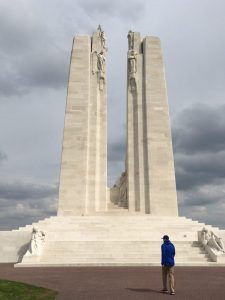
On April 9, Canadians commemorated the 100th anniversary of the Battle of Vimy Ridge in the First World War.
Vimy Ridge is in France, and it was there that a Canadian military force took back the area from the Germans in a battle that many people at the time considered unwinnable. It was an ugly, horrific battle, with more than 10,000 soldiers wounded or killed, but it proved to be a turning point in the war.
Because the victory at Vimy Ridge was the result of careful planning, strategy, bravery and perseverance in the face of an enormous challenge, it is considered by many Canadians to be an important symbol of Canadian accomplishment.
A stunning monument, the Canadian National Vimy Memorial, is on the site where the battle took place. It was unveiled in 1936, and it sits on land that the French government has given to Canada in perpetuity (forever). The sculpture honours the Canadians who died in France and features their names; it honours the soldiers, most of whom have know known graves. The memorial was created by Canadian sculptor Walter Allward.
This year, as many as 25,000 Canadians travelled to Vimy, France, to honour the courage of the people who died in the battle that took place 100 years ago.
Canadian Prime Minister Justin Trudeau, Princes Harry, William and their father Charles, the President of France, François Hollande, and other dignitaries attended the ceremony.
Actors re-enacted scenes from the lives of soldiers who had fought at Vimy, to give people a sense of what the soldiers were thinking and feeling before the battle. Dancers and singers helped to bring the emotion of the event to life. Current members of the Canadian Armed Forces and other soldiers paraded as well.
Related links
Veterans Affairs Canada offers teachers this lesson plan about Vimy Ridge:
http://www.veterans.gc.ca/eng/remembrance/information-for/educators/learning-modules/vimy-ridge/civilian-shoes-to-combat-boots
The Battle of Vimy Ridge, Canadian War Museum website: http://www.warmuseum.ca/the-battle-of-vimy-ridge/

The Vimy Memorial is an awe-inspiring monument to the Canadians who died in France 100 years ago. This web page, by the Canadian War Museum, has more information about this stunning tribute. http://www.warmuseum.ca/the-battle-of-vimy-ridge/the-sculptures-on-the-vimy-memorial/#tabs
CURRICULUM CONNECTIONS
By Jonathan Tilly
Writing/Discussion Prompt
Today’s article concludes by mentioning how actors, dancers, and singers made performances at the ceremony. How might these performances “give people a sense of what the soldiers were thinking and feeling before the battle” and “to bring the emotion of the event to life?”
Reading Prompt: Making Inferences
Canadian Brigadier-General A.E. Ross during the Canadian victory at Vimy Ridge, “I witnessed the birth of a nation.” What do you think he meant by this and why do you think he might have said it?
Primary
Make inferences about texts using stated and implied ideas from the texts as evidence (OME, Reading: 1.5).
Junior
Use stated and implied ideas in texts to make inferences and construct meaning (OME, Reading: 1.5).
Intermediate
Develop and explain interpretations of increasingly complex or difficult texts using stated and implied ideas from the texts to support their interpretations (OME, Reading: 1.5).
Language Feature: Words with a prefix and suffix
Today’s article includes the word, “unwinnable.” “Unwinnable” is a unique word because the root word (win) has a prefix before it (un) and a suffix that follows (able). Both prefixes and suffixes change/modify the meaning of the root word. Here are several other examples: unbelievable, dehydration, unbreakable, unbelievable.
Create 5 of your own examples.







